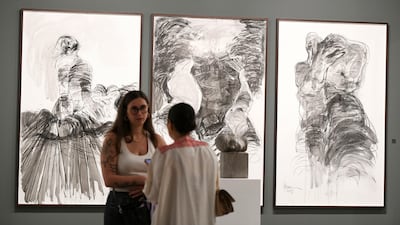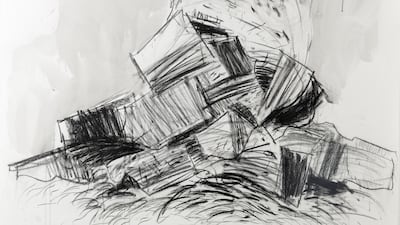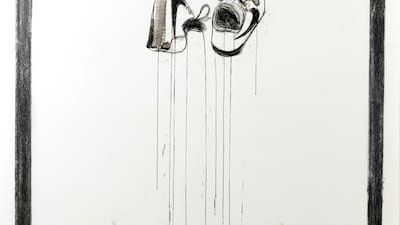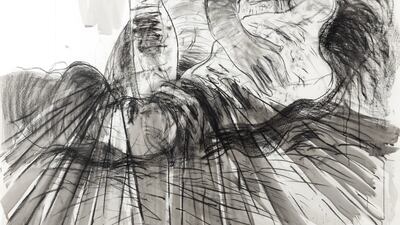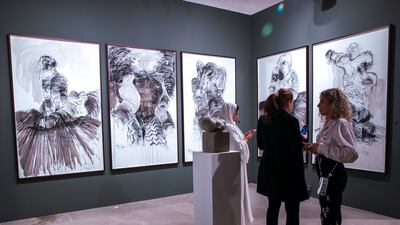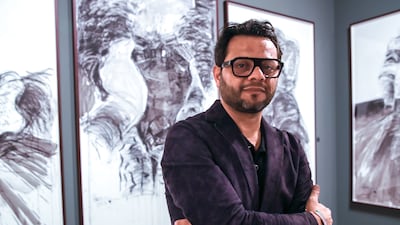The only written words in the new body of work by Palestinian visual artist Hazem Harb is a line from a poem.
“And to give your skin in exchange for an olive.”
The words by Palestinian poet and author Mahmoud Darwish, from his poem In Praise of the High Shadow, are sketched in the foreground, where an inferno blazes behind them.
A disfigured body rises from demolished homes – twisting, writhing and reaching out from the wreck. It is colossal and harrowing. Even Harb’s gestures – the lines, shading and drips – transcribe a set of distributing emotions that are felt more than they are understood.
This is one of eight charcoal drawings and a sculpture from Harb’s new series entitled Dystopia is not a Noun showing at Tabari Artspace’s booth at Abu Dhabi Art.
Those familiar with Harb's work will be surprised to see that instead of the meticulously crafted collages of archival images he's known for, he is painting again.
“Everything has changed, my mind, my studio, my desk, my materials, my personal life, my professional life, my attitude, approach as an artist, everything has changed,” Harb tells The National.
“I never expected that I’d go back to painting. But my life has now turned upside down.”
Harb is a Gazan native with numerous family members still residing there. As of Thursday, when The National spoke to the artist in his studio in Jumeirah, he hadn’t heard from some of his family for a few days, including his father. All he knew was that his sister and her four children were staying with family friends and that their neighbourhood had been completely demolished.
The history of violence, its ripple across generations, has always been a central theme in his work.
However, in the past, Harb approached this violence within concepts of identity and home, repurposing ideas of history, archival documents and images into his work. He never leaned into cliched notions of nostalgia or tropes of victimhood and oppression as a Palestinian artist.
But now with what’s happening, he says, this is impossible.
As a means to distil and understand what is overwhelming every aspect of his person in the present moment, Harb picked up a piece of charcoal and began to draw two weeks ago.
“Charcoal is coal, its blackness, its soot, smoke, its filled with darkness,” he says.
“Charcoal is the only medium that can express truthfully, what feels authentic, what is immediate, right now. It was the medium that can transcribe exactly how I’m feeling, without words.”
Concrete, ash, flesh, body, all become one in each drawing.
Figures emerge out of one another, out of darkness, from smoke and destruction. There are recognisable elements within the chaos. The keffiyeh, spilling from beneath arms holding up a featureless face. Covered in darkness, the face morphs into thatched homes piled like disgorged play things, enveloped by billowing towers of smoke.
“You know the city has turned into ash,” Harb says. “If you look at the images and videos coming out of Gaza, out of the destruction, their faces have become the colour of ash.”
And there, another disturbing layer to his work.
Harb grapples with the idea that the human body, conceptually and physically is connected to the home and land during times of war. Whether running from home or standing firmly in it, unwilling to leave, to be bombed in it, Hazem’s images dissect these ideas in an arresting and tormenting reality.
“I wanted to connect the body to the place,” he says. “The demolition, the destruction, the sense of loss that’s happening to the physical land and to the bodies of people – these are all connected.”
While his technique is stunning, Harb’s dialogue with the canvas is marred with violence we recognise and some we can’t begin to fathom.
From the compositions to the angles and poses of the figures, we see a melding of pictorial languages.
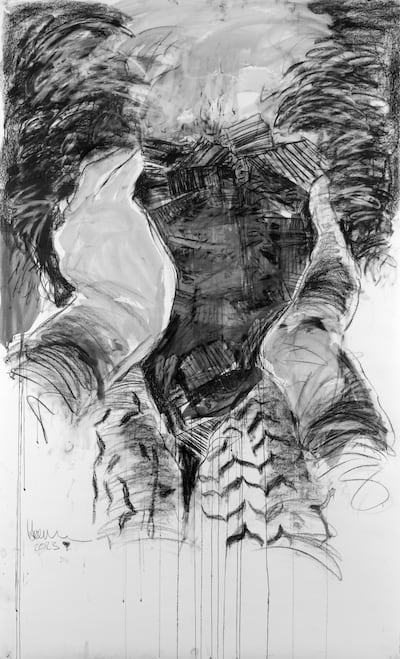
The viewer recognises how the media captures and packages images of conflict, of bombed neighbourhoods and bodies of the injured and dying, in both conventional ways and now how these realities present themselves in the endless newsfeeds on social media.
Through his work, Harb connects with something primitive and instinctual. He allows the technical aspect of his artmaking to inform his hand subconsciously as he dips into and retreats from the images of his city being bombed to the indescribable emotions he feels as a son, a brother, a human and a Palestinian.
“I was trying to escape the rational or technical part of my art and focus on being honest with myself in the moment,” he says.
“I don’t want to say that art healed me, it also helped save me a little during this time from my personal pain.”
Harb thinks for some time when he’s asked about the function of art during times like this. He’s surrounded in his studio by reminders of his homeland – cushions embroidered in Tatreez, a traditional Palestinian art form; a second-hand book Flowers and Trees of Palestine by Augusta A Temple published in 1907; and three keys to his family’s ancestral homes passed down to him.
“It isn’t art’s responsibility to change the world. It can, at least, express humanity's disasters, express things that cannot be said in the news and through politicians,” he says.
“So of course, art matters.”
